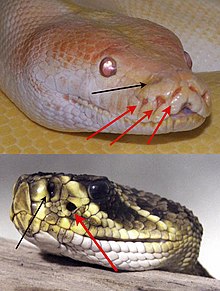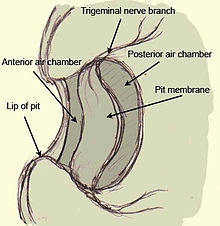Infrared sensing in snakes

The ability to sense
Phylogeny and evolution
The facial pit underwent
Anatomy
In

Neuroanatomy
In all cases, the facial pit is innervated by the trigeminal nerve. In
It is the optic tectum of the brain which eventually processes these infrared cues. This portion of the brain receives other sensory information as well, most notably
The nerve fibers in the pit organ are constantly firing at a very low rate. Objects that are within a neutral temperature range do not change the rate of firing; the neutral range is determined by the average thermal radiation of all objects in the receptive field of the organ. The thermal radiation above a given threshold causes an increase in the temperature of the nerve fiber, resulting in stimulation of the nerve and subsequent firing, with increased temperature resulting in increased firing rate.[10] The sensitivity of the nerve fibers is estimated to be <0.001 °C.[11]
The pit organ will adapt to a repeated stimulus; if an adapted stimulus is removed, there will be a fluctuation in the opposite direction. For example, if a warm object is placed in front of the snake, the organ will increase in firing rate at first, but after a while will adapt to the warm object and the firing rate of the nerves in the pit organ will return to normal. If that warm object is then removed, the pit organ will now register the space that it used to occupy as being colder, and as such the firing rate will be depressed until it adapts to the removal of the object. The latency period of adaptation is approximately 50 to 150 ms.[10]
The facial pit actually visualizes thermal radiation using the same optical principles as a
Molecular mechanism
In spite of its detection of infrared light, the infrared detection mechanism is not similar to photoreceptors - while photoreceptors detect light via photochemical reactions, the protein in the pits of snakes is a type of transient receptor potential channel, TRPA1 which is a temperature sensitive ion channel. It senses infrared signals through a mechanism involving warming of the pit organ, rather than chemical reaction to light.[12] In structure and function it resembles a biological version of warmth-sensing instrument called a bolometer. This is consistent with the very thin pit membrane, which would allow incoming infrared radiation to quickly and precisely warm a given ion channel and trigger a nerve impulse, as well as the vascularization of the pit membrane in order to rapidly cool the ion channel back to its original temperature state. While the molecular precursors of this mechanism are found in other snakes, the protein is both expressed to a much lower degree and is much less sensitive to heat.[12]
Behavioral and ecological implications
Infrared sensing snakes use pit organs extensively to detect and target warm-blooded prey such as rodents and birds. Blind or blindfolded rattlesnakes can strike prey accurately in the complete absence of visible light,[13][14] though it does not appear that they assess prey animals based on their body temperature.[15] In addition, snakes may deliberately choose ambush sites that facilitate infrared detection of prey.[16][17] It was previously assumed that the organ evolved specifically for prey capture.[11] However, recent evidence shows that the pit organ may also be used for thermoregulation. In an experiment that tested snakes' abilities to locate a cool thermal refuge in an uncomfortably hot maze, all pit vipers were able to locate the refuge quickly and easily, while true vipers were unable to do so. This suggests that the pitvipers were using their pit organs to aid in thermoregulatory decisions.[4] It is also possible that the organ may even have evolved as a defensive adaptation rather than a predatory one, or that multiple pressures may have contributed to the organ's development.[5] The use of the heat pit to direct thermoregulation or other behaviors in pythons and boas has not yet been determined.
See also
References
- PMID 7256281.
- PMID 4350276.
- ^ "Snake infrared detection unravelled". Archived from the original on 28 December 2016. Retrieved 20 January 2017.
- ^ PMID 15531644.
- ^ ISBN 0-9630537-0-1.
- ^ Pough et al. 1992. Herpetology: Third Edition. Pearson Prentice Hall: Pearson Education, Inc., 2002.
- PMID 12711259.
- S2CID 10279222.
- PMID 628839.
- ^ S2CID 30122231.
- ^ PMID 17690227
- ^ PMID 20228791.
- PMID 28855322.
- JSTOR 1564650.
- S2CID 3370317.
- PMID 30850649– via in review.
- .
